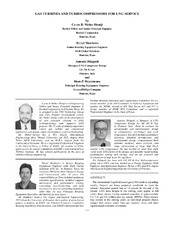| dc.description.abstract | The international liquefied natural gas (LNG) trade is expanding rapidly. Projects are being proposed worldwide to meet the industry forecasted growth rate of 12 percent by the end of the decade. LNG train designs in the coming years appear to fall within three classes, having nominal capacities of approximately 3.5, 5.0, and 8.0 million tons per annum (MTPA). These designs may coexist in the coming years, as individual projects choose designs that closely match their gas supplies, sales, and other logistical and economic constraints. The most critical component of an LNG liquefaction facility is the refrigeration compressors and their drivers. These represent a significant expense and strongly influence overall plant performance and production efficiency. The refrigeration compressors themselves are complex and challenging to design due to high Mach numbers, large volume flows, low inlet temperatures, and complex sidestream mixing. Drivers for these plants include gas turbines that range in size from 30 MW units to large Frame 9E gas turbines. Aeroderivative engines have also been recently introduced. This paper comprehensively covers the design, application, and implementation considerations pertaining to both LNG plant drivers and compressors. The paper does not focus on any particular LNG process but just addresses turbomachinery design and application aspects that are common to all processes. Topics cover key technical design issues and complexities involved in the turbomachinery selection, aeromechanical design, testing, and implementation. The paper attempts to highlight the practical design compromises that have to be made to obtain a robust solution from a mechanical and aerodynamic standpoint. | en |


